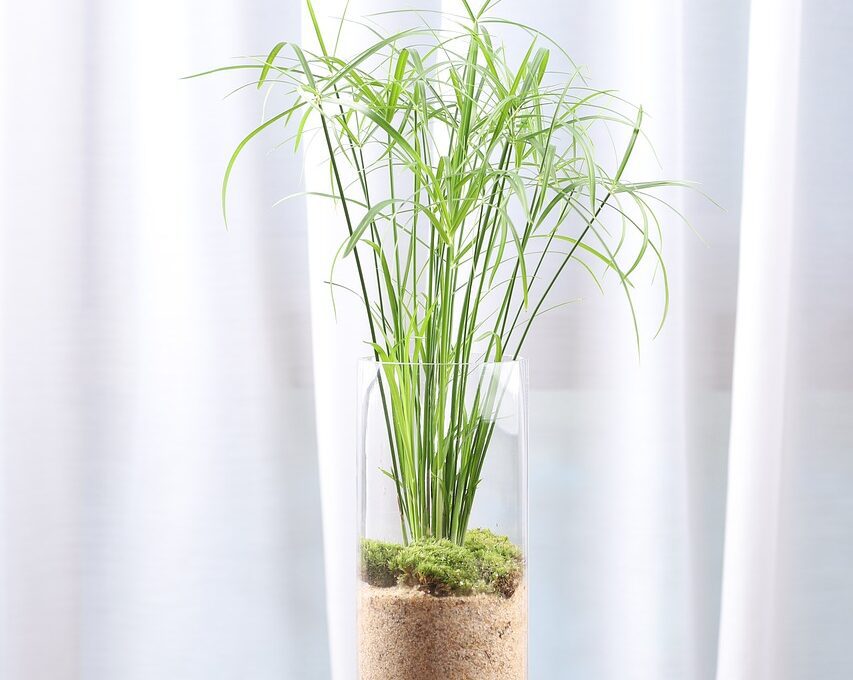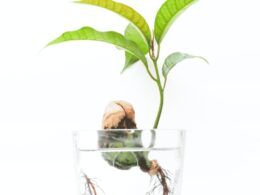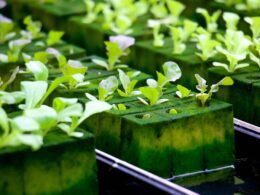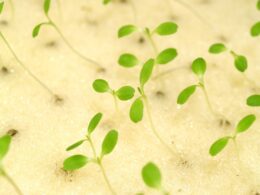Are you considering starting a hydroponic system but unsure about what kind of soil you need? Choosing the right growing medium is crucial for the success of your crops.
In hydroponics, soil is replaced by a growing medium that provides support, nutrients, and oxygen to the plants. Using the wrong type of growing medium can lead to poor plant growth, nutrient deficiencies, and even plant death.
It is essential to understand the different types of growing media available, the factors to consider when choosing one, and how to prepare it for your hydroponic system. With the right knowledge and preparation, you can ensure a safe and bountiful harvest.
Understand the Importance of Choosing the Right Growing Medium
Choosing the appropriate growing medium is crucial for optimizing plant growth and yield in hydroponic systems. One of the most important things to consider is the pH balance of the medium. An ideal pH level for hydroponic systems is between 5.5 and 6.5. If the pH level is too high or too low, it can affect the plant’s ability to absorb nutrients. Therefore, it’s important to choose a growing medium that can maintain the pH level within the desired range.
Another critical factor when selecting the right growing medium is choosing the right nutrients for hydroponics. Different plants have different nutritional requirements, and it’s essential to choose the right nutrients for the type of plant you’re growing. Some plants may require more nitrogen, while others may need more potassium or phosphorus. The growing medium you choose should be able to hold and distribute the nutrients needed by your plants.
In conclusion, choosing the right growing medium is vital for the success of your hydroponic system. The pH balance and nutrient content of the medium are essential factors to consider when selecting a growing medium. Make sure to choose a medium that can maintain the appropriate pH balance and distribute the necessary nutrients to your plants. With the right growing medium, you can maximize plant growth and yield in your hydroponic system.
Types of Growing Media Suitable for Hydroponics
When it comes to hydroponics, you’ve got a variety of options for growing media. Rockwool is a popular choice as it has good water retention and can be reused.
Perlite is lightweight and helps with drainage, while coconut coir is also a great option for moisture retention. Expanded clay pellets and vermiculite are also commonly used in hydroponic systems for their ability to hold water and provide a stable environment for plants.
Consider these options when choosing a growing medium for your hydroponic setup.
Rockwool
To get the most out of your hydroponic system, try using rockwool as a growing medium. Its benefits are unparalleled, especially when compared to other growing media.
Rockwool is made of spun basaltic rock that’s heated to extremely high temperatures, creating a fibrous and porous material that’s perfect for hydroponic gardening.
One of the biggest benefits of rockwool is its ability to retain water and oxygen while still allowing for excellent drainage. This means that your plants will have access to all the water and nutrients they need, while also allowing for proper air circulation around the roots.
Rockwool also provides an ideal environment for root growth, which is crucial for the overall health and productivity of your plants. So, if you’re looking for a reliable, effective, and safe option for your hydroponic system, consider using rockwool as your growing medium.
Perlite
Perlite, a lightweight and porous volcanic glass, is a great option for creating a well-draining and airy environment for your plants in a hydroponic system. Here are some benefits of using perlite in your hydroponics setup:
-
It allows for excellent aeration: Perlite has a highly porous structure that allows for ample air circulation and ventilation for the roots of your plants.
-
It’s lightweight: Compared to other hydroponic growing media, perlite is incredibly lightweight, making it easy to handle and move around as needed.
-
It’s pH-neutral: Perlite doesn’t have any significant impact on the pH of your nutrient solution, making it a stable option for hydroponic gardening.
-
It’s cost-effective: Perlite is an affordable option for hydroponic growing media, making it a practical choice for those on a budget.
When comparing perlite to other hydroponic growing media, it’s clear that perlite is a top choice due to its excellent aeration properties, light weight, pH neutrality, and cost-effectiveness. It’s a safe and reliable option for creating a healthy growing environment for your hydroponic plants.
Coconut Coir
If you’re looking for an alternative to perlite, coconut coir is a great option that provides excellent water retention and nutrient absorption for your plants. Coconut coir is made from the fibrous husks of coconuts, and it’s a renewable resource that’s environmentally friendly. It’s also more sustainable than peat moss, which is commonly used in traditional gardening but isn’t a renewable resource.
One of the benefits of coconut coir is that it’s naturally pH balanced, which means you don’t have to adjust the pH levels as much as you would with other soilless mediums. Additionally, coconut coir has a high cation exchange capacity, which means it can hold onto nutrients and release them to your plants as needed.
To use coconut coir in hydroponics, it’s important to rinse it thoroughly with water before use to remove any excess salts that may be present. You can also mix coconut coir with other soilless mediums, such as perlite or vermiculite, to create a well-balanced growing medium that provides optimal conditions for your plants.
Expanded Clay Pellets
Now that you know about coconut coir, let’s talk about another option for hydroponic soil: expanded clay pellets. These pellets, also known as Hydroton alternatives, are popular among hydroponic growers for many reasons.
One of the benefits of using expanded clay pellets is their ability to retain moisture and provide excellent aeration for plant roots. This is due to their porous nature and ability to absorb water while still maintaining air pockets.
Additionally, they’re pH neutral and don’t break down easily, providing a stable environment for plants to grow in. So, if you’re looking for a reliable and cost-effective soil alternative for your hydroponic system, consider giving expanded clay pellets a try.
Vermiculite
You might be surprised by the benefits of using vermiculite as a hydroponic medium. This mineral-based material is known for its ability to improve moisture retention and aeration for your plants. Vermiculite has a unique structure that can hold water and nutrients, which makes it ideal for hydroponics. It can also help to prevent soil compaction, which can lead to root damage and poor growth.
One of the pros of using vermiculite as a growing medium is that it’s lightweight and easy to handle. It’s also affordable and widely available, making it a popular choice for many hydroponic growers. However, there are some cons to using vermiculite as well. It has a low cation exchange capacity, which means that it can’t hold onto nutrients for very long. Additionally, vermiculite has a tendency to break down over time, which can lead to clogs in your hydroponic system.
When comparing vermiculite to other growing media, it’s important to consider these factors and choose the medium that’s best suited for your specific growing needs.
Factors to Consider When Choosing the Right Growing Medium
Choosing the perfect growing medium is crucial to ensure your hydroponic plants thrive, so it’s important to consider factors like water retention and nutrient availability. One of the main factors to consider is the pH level of your medium. Different plants thrive in different pH levels, so make sure to choose a medium that’s appropriate for the plants you want to grow.
Another important factor is the texture of your medium. A medium that’s too dense can prevent water from flowing properly, while a medium that’s too loose can cause poor root support.
When choosing a growing medium, it’s also important to consider the benefits of hydroponic growing. Hydroponics allows you to control the nutrients your plants receive, which can result in faster growth and higher yields. Additionally, hydroponic growing eliminates the need for soil, which can reduce the risk of pests and diseases.
However, it’s important to remember that not all growing mediums are created equal. Some may be better suited for certain plants or growing methods, so do your research and choose a medium that fits your specific needs.
In summary, choosing the right growing medium is a crucial step in ensuring the success of your hydroponic garden. Consider factors like pH level and texture, and don’t forget to take advantage of the benefits of hydroponic growing. With the right medium, you can create a thriving garden that produces healthy and delicious crops.
How to Prepare Your Growing Medium
Get ready to prepare your growing medium and watch your hydroponic plants thrive! Before anything else, you need to pH balance your growing medium. This is important because hydroponic plants are sensitive to pH changes in the water.
The ideal pH level for hydroponics is between 5.5 and 6.5. You can use a pH testing kit to check the pH level of your water. Adjust the pH level by adding either pH up or pH down solution until you reach the desired level.
After pH balancing your growing medium, the next step is to infuse it with nutrients. Nutrient infusion is crucial in hydroponics because plants rely solely on the nutrients present in the water to grow.
You can use commercially available hydroponic nutrient solutions to infuse your growing medium. These nutrient solutions come in different types, depending on the stage of growth of your plants. Be sure to follow the instructions on the nutrient solution packaging to avoid overfeeding your plants.
Once you’ve pH balanced and infused your growing medium with nutrients, it’s time to fill your hydroponic system with it. Be sure to pack the medium tightly to prevent it from shifting or settling. Also, avoid overfilling the system to prevent flooding or waterlogging.
With these simple steps, you can prepare your growing medium and provide your hydroponic plants with a healthy environment to thrive in.
Conclusion: Choosing the Right Growing Medium for Your Hydroponic System
Now that we’ve covered how to prepare your growing medium, let’s talk about why selecting the right medium for your hydroponic system can make all the difference in the success of your plants.
The truth is that hydroponic plants don’t require soil at all. Instead, soilless options like Rockwool, perlite, vermiculite, or coconut coir are commonly used as growing mediums. These options provide a stable environment for the plant’s roots, allowing for maximum nutrient absorption and oxygenation.
When choosing a growing medium, it’s important to consider the pH balance. A pH range of 5.5 to 6.5 is ideal for most hydroponic plants. If the pH is too high or too low, the plants will struggle to absorb nutrients, leading to stunted growth or even death. Keep in mind that different growing mediums have different pH levels, so it’s crucial to test and adjust the pH as needed.
In summary, selecting the right growing medium is essential to the success of your hydroponic system. Soilless options like Rockwool, perlite, vermiculite, or coconut coir provide a stable environment for the plant’s roots, while also allowing for maximum nutrient absorption and oxygenation. Just remember to test and adjust the pH balance to ensure that your plants can thrive in their new home.
Frequently Asked Questions
Do I need to change the growing medium between plant cycles?
When it comes to hydroponics, choosing the right growing medium is crucial for plant growth and success. Benefits of using different growing mediums in hydroponics include better drainage and aeration, as well as the ability to retain moisture and nutrients. However, factors to consider when selecting a growing medium for hydroponics include the plant species being grown, the size of the system, and the pH level of the nutrient solution.
It’s recommended to change the growing medium between plant cycles to prevent the buildup of harmful bacteria and pathogens. By selecting the right growing medium and regularly changing it, you can ensure healthy and thriving plants in your hydroponic system.
Can I use soil as a growing medium in hydroponics?
If you’re looking for an alternative to soil in hydroponics, there are plenty of options available. While you can technically use soil as a growing medium in hydroponics, it’s generally not recommended. This is because it can clog up your system and lead to nutrient imbalances. Instead, many hydroponic growers opt for soil alternatives such as coco coir, perlite, or vermiculite.
The benefits of hydroponics are numerous. You can experience faster growth rates, higher yields, and more control over your plants’ environment. Plus, with no soil to contend with, you can avoid issues like pests, disease, and soil-borne pathogens.
So, if you’re ready to take your gardening game to the next level, consider giving hydroponics a try!
How often do I need to replace the growing medium?
When it comes to hydroponics, it’s important to maintain a healthy growing medium for your plants. One option that’s gaining popularity is using coconut coir as a growing medium. This natural material is renewable, sustainable, and provides excellent water retention and aeration.
However, regardless of what growing medium you use, it’s important to monitor and maintain the pH levels to ensure optimal plant growth. Over time, the growing medium may become depleted of nutrients and may need to be replaced.
The frequency of replacement depends on factors such as the type of plants you’re growing, the size of your system, and the quality of your water. By keeping an eye on the pH levels and periodically replacing the growing medium, you can ensure that your plants have a healthy environment to grow in.
Are there any organic alternatives to traditional growing media?
When it comes to sustainability in hydroponics, using organic substitutes as growing media is a great option. Instead of traditional materials like rockwool or peat moss, you can use coconut coir, perlite, or even sawdust.
These organic alternatives not only reduce waste and environmental impact but also provide a natural source of nutrients for your plants. Plus, they can be reused multiple times before needing to be replaced, making them a cost-effective choice.
By choosing organic substitutes as your growing media, you can enjoy a more sustainable and eco-friendly approach to hydroponics.
Can I reuse the growing medium from a previous crop?
If you’re considering reusing the growing medium from a previous crop in your hydroponic system, it’s important to consider the potential risks and benefits. One major benefit of sterilization is that it can help kill off any harmful pathogens or pests that may have developed in the medium from the previous crop. This can help ensure that your current crop grows healthy and strong.
However, keep in mind that even with sterilization, there may still be some residual contaminants in the medium, so it’s important to monitor your plants closely for any signs of distress. Additionally, you may want to consider alternative growing mediums that are less prone to contamination, such as coconut coir or vermiculite.
Overall, the decision to reuse or replace your hydroponic growing medium will depend on a variety of factors, including your budget, the type of crop you’re growing, and your personal preferences.
Conclusion
So, there you have it! Choosing the right growing medium for your hydroponic system is crucial to the success of your plants.
Remember that hydroponics is all about growing plants without soil, so you need to choose a growing medium that can provide the necessary support and nutrients your plants need to thrive.
Be sure to consider factors such as water retention, aeration, pH levels, and the type of plant you’re growing when choosing your growing medium. And don’t forget to properly prepare your growing medium before planting to ensure the best results.
With a little research and preparation, you’ll be on your way to a thriving hydroponic garden in no time. Happy growing!









